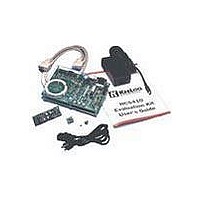DM303006 Microchip Technology, DM303006 Datasheet - Page 27

DM303006
Manufacturer Part Number
DM303006
Description
KIT EVALUATION KEELOQ
Manufacturer
Microchip Technology
Series
KEELOQ®r
Type
KeeLoq®r
Specifications of DM303006
Silicon Manufacturer
Microchip
Kit Contents
Main Board, 2 Transmitters, Cables And Power Supply
Tool / Board Applications
General Purpose MCU, MPU, DSP, DSC
For Use With
KeeLoq
Lead Free Status / RoHS Status
Request inventory verification / Request inventory verification
For Use With/related Products
Keeloq Encoders & Decoders
Lead Free Status / RoHS Status
Lead free / RoHS Compliant, Request inventory verification / Request inventory verification
7.4
All K
ing new transmitters to the system without the need to
reprogram the system. During the learning process, the
decoder identifies the transmitter and stores its param-
eters (key and synchronization information) in non-vol-
atile memory for future use. After learning, the decoder
will recognize the transmitter and respond to it nor-
mally.
The decoder’s learning capability also simplifies the
replacement of lost transmitters. When a transmitter is
lost, the user can “teach” the decoder the key of the
replacement transmitter. Different decoders have dif-
ferent
transmitters that can be learned (see Table 7-1).
When a transmitter is lost, it is advisable to erase the
memory and re-learn the existing transmitters. This will
deny the lost transmitter access to the system.
Learning a transmitter is a two-phase process. During
the learn process a key is generated by the decoder.
The key is stored with the transmitter’s serial number
and synchronization information after the key has been
verified.
The key generation process has three inputs. The first
is the source of the key generation. The source can be
the encoder’s serial number (normal learn) or the
encoder’s seed (secure learn). The second input is the
key generation algorithm; the decryption algorithm or
the XOR algorithm. The third input to the system is a
manufacturer’s key. The manufacturer’s key tailors the
key generation algorithm to a specific manufacturer.
Customizing the key generation algorithm means com-
petitors cannot clone another manufacturer’s transmit-
ters.
With the exception of the Simple Decoder, two trans-
missions are needed by the decoder during learn: one
to generate a key and the second to validate the key. If
the key generation source is the serial number then
both transmissions will be normal Code Hopping trans-
missions. If the user chooses secure learn (Seed value
as the key generation source) the first transmission
should be a Code Hopping transmission and the sec-
ond transmission a “Seed transmission”. Seed trans-
missions
combination of buttons. In the case of the HCS300, a
seed transmission is activated by simultaneously
pressing all four buttons S0 – S3.
The Evaluation Kit II software and PRO MATE II soft-
ware (Microchip Universal Programmer) have been
designed so that the Encoder Key Generation phase is
transparent to the user.
2001 Microchip Technology Inc.
EELOQ
capacities in terms of maximum number of
Learning New Transmitters
are
decoders support transmitter learning; add-
obtained
by
pressing
K
a
EE
special
L
OQ
®
EVALUATION KIT II USER’S GUIDE
7.4.1
Learning a transmitter on the NORMAL,SECURE soft-
ware decoders and HCS512 decoders is accomplished
as follows:
1.
2.
3.
4.
5.
7.4.2
In SIMPLE Learn all encoders and decoders share a
common key that coincides with the Manufacturer’s
Code. As a consequence, the system security is dimin-
ished but the decoder code to implement it is shorter.
The learn procedure flows as follows:
1.
2.
3.
Note:
Press and release the decoder’s LEARN button.
The LEARN OUT LED will turn on to indicate
that the decoder has entered Learn mode.
Press a transmitter button. The LEARN LED will
turn off, indicating a transmission has been
received.
Press a transmitter button a second time. The
LEARN LED will flash several times to indicate
that the transmitter was learned successfully
The learning attempt will fail if the transmitter is
not configured to operate in the same Learn
Scheme as the decoder, the Manufacturer Code
is different, two non-sequential codes are
received, two acceptable codes are not received
within 30 seconds, or simply if the radio trans-
mission was corrupted by noise. The decoder
indicates a failed learn by making the LED flash
briefly once. Try again starting from step 1.
If Learning fails again, the user is recommended
to verify the Manufacturer’s Code and Learning
Scheme of the encoder and decoder match.
If step 3 succeeded, repeat steps 1-3 to learn up
to the maximum number of transmitters.
Press and release the LEARN button. The
LEARN OUT LED will turn on while the button is
pressed and turn off when the button is
released.
Press any transmitter button.
The LEARN OUT LED will turn on for a second
if the Learn is successful. If the transmission is
not acceptable the decoder will return to normal
operation. Unacceptable transmissions result if
the encoder is configured with a different Manu-
facturer’s Code or a transmission is not received
within 30 seconds
The second transmission must be a
SEED transmission when secure learn
is used.
LEARNING PROCEDURE STEP BY
STEP
LEARNING ON A SIMPLE
DECODER STEP BY STEP
DS41155A-page 25











